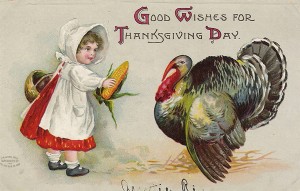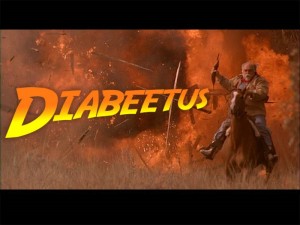Gumbo Healthy?
The Stay Healthy, Louisiana! blog (from the Louisiana Public Health Institute) posted that a gumbo z’herbes recipe from the New Orleans School of Cooking was featured in Shape magazine. Who says Louisiana food can’t be healthy?
The Stay Healthy, Louisiana! blog (from the Louisiana Public Health Institute) posted that a gumbo z’herbes recipe from the New Orleans School of Cooking was featured in Shape magazine. Who says Louisiana food can’t be healthy?
 |
The Isché Library is closed today through Saturday. It will re-open on Sunday, November 27th at 1:30 pm. The Dental Library remains closed for repairs. |
The Library is looking for a part-time student worker for evenings and weekends.?á Pick up an application at the Circulation Desk.
The Isch?® Library Thanksgiving Holiday Hours are as follows:
Tuesday, November 22nd 8 am – 10 pm
Wednesday, November 23rd 8 am – 6 pm
Thursday, November 24th CLOSED
Friday, November 25th CLOSED
Saturday, November 26th CLOSED
We will reopen on Sunday, November 27th 1:30 – 10 pm for Regular Hours.
The Dental Library remains closed for HVAC repairs.
Our next installment of 2 Minute Tips shows how you can search our catalog for a required textbook.
INNOPAC Course Reserves
2 Minute tips is a blog series where we bring you short video tutorials on various tools and resources in the library.
Growing up, my mother always cooked her stuffing in the turkey. It was delicious, the stuffing not the turkey, that was more of a centerpiece. Little did we know back then that we were living on the edge.
Food poisoning will put a serious crimp in your Black Friday plans, my friend. If you cringe every time you see your Aunt Martha wipe down the counters with a sponge that has been in her sink since the pilgrims landed or you get queasy when you see your nephew touch every dinner roll with his grubby hands before putting one on his plate, check out this site and forward it with offending family members under the guise of sharing recipes.
And if you’re still one of the few who cook their stuffings in the bird, err on the side of caution and invest in a food thermometer. Who doesn’t need a new kitchen gadget anyway?
You can now register the same Dynamed serial number on up to 5 devices of the same operating system.
From Skyscape:
For example, if you have registered DynaMed on your iPhone, you can install it to your iPad using the same serial number. When you install Skyscape/DynaMed on the iPad, all of the resources that were registered to your iPhone are automatically installed. This behavior will also apply to the Android and BlackBerry platforms.
Serial numbers have a shelf life of one year, regardless of how many devices on which it is registered. Contact the library for a new serial number if Dynamed has stopped working for you.
Dynamed provides clinically-organized summaries with references for nearly 3,200 diseases and condition topics and over 800 drugs. It is available free to faculty, staff and students of LSUHSC.
Surprisingly, just about every 20 seconds a child under age 5 succumbs to the disease pneumonia. ?áIn its 2nd year of existence, the Global Coalition against Child Pneumonia is raising awareness about the disease. It is preventable and there are effective and affordable options that help protect children. The symptoms include but are not limited to: cough, shaking chills, fever, fatigue, and muscle pain. Its symptoms often mimic those of the flu but when it doubt, get checked out.
?áFor more info, visit:
Chancellor Hollier announced a brief Veteran’s Day Ceremony on Friday, November 11th via email today.
“We will have a brief ceremony on Veterans Day to honor veterans and current military at LSU Health Sciences Center. So, weÔÇÖre asking LSUHSC vets and service men and women to gather at 10:15 a.m. in front of 2020 Gravier Street this Friday, November 11, 2011. Vice Chancellor Ron Gardner, a Vietnam veteran, will say a few words, and weÔÇÖll take a photo.
LSU Health Sciences Center is grateful for your sacrifice and your service, and we are proud that you have chosen to carry it forward to a lifetime of service as academic and health professionals.”

Have you ever considered that your hair stylist might be one of your greatest advocates in the battled against skin cancer?
Probably not, but according to an article published by amednews.com (published by the American Medical Association), ÔÇ£Nearly 60% of 203 hair professionals surveyed at 17 salons in the Houston area said they already had recommended at least once that a customer see a health professional for an abnormal mole.ÔÇØ
The article goes on to suggest the benefits of training Hair professionals on how to detect the early signs and appearances of scalp, neck and face cancer. Good to know there is one more benefit to taking a little time
for pampering!
Read the full article here.
Royal Society Publishing has opened their archive to the public free of charge. This archive includes “all articles from Philosophical Transactions of the Royal Society, first published in 1665 and officially recognised as the world’s first ever peer-reviewed journal.” The archive covers 250 years of scientific discovery and includes covers all the publishers journals. Only articles more than 70 years old will be accessible. My favorite from the first volume (1665) is “A Relation of Persons Killed with Subterraneous Damps.”
LSUHSC Libraries do have access to the most recent content that is not free to the public. Access to recent matieral is available to LSUHSC faculty, staff & students. It can be accessed off-campus with a valid LSUHSC library barcode & PIN. You can find more information at our remote access webpage.
 Another round of eight articles authored by LSUHSC-NO researchers is being displayed in the Library. The publications on are on view in the Library’s Reference area (near the Library elevator) on the third floor of the Resource Center Building, and are also part of the Library’s Faculty Publications Database.
Another round of eight articles authored by LSUHSC-NO researchers is being displayed in the Library. The publications on are on view in the Library’s Reference area (near the Library elevator) on the third floor of the Resource Center Building, and are also part of the Library’s Faculty Publications Database.
The Faculty Publications Database includes publications authored by at least one member of the LSUHSC-New Orleans faculty, 1998 – present. Access to this database is available to the public. The database is linked from the Library web page here. This page includes a handy link to a PDF of the monthly bibliography of display articles. To add your faculty publications, or for questions about this database, contact Kathy Kerdolff.
LSUHSC-NO authors are shown in bold print:
1. Anthony L, Vinik AI. “Evaluating the characteristics and the management of patients with neuroendocrine tumors receiving octreotide LAR during a 6-year period.” Pancreas. 2011; 40(7): 987-994.
2. Lecapitaine NJ, Wang ZQ, Dufour JP, Potter BJ, Bagby GJ, Nelson S, Cefalu WT, Molina PE. “Disrupted anabolic and catabolic processes may contribute to alcohol-accentuated SAIDS-associated wasting.” Journal of Infectious Diseases. 2011; 204(8): 1246-1255.
3. Osofsky HJ, Osofsky JD, Arey J, Kronenberg ME, Hansel T, Many M. “Hurricane Katrina’s first responders: The struggle to protect and serve in the aftermath of the disaster.” Disaster Medicine & Public Health Preparedness. 2011; 5 Suppl 2 S214-9.
4. Richmond N, Tran T, Berry S. “Receipt of transition services within a medical home: Do racial and geographic disparities exist?” Maternal & Child Health Journal. 2011; 15(6): 742-752.
5. Rom S, Pacifici M, Passiatore G, Aprea S, Waligorska A, Del Valle L, Peruzzi F. “HIV-1 tat binds to SH3 domains: Cellular and viral outcome of Tat/Grb2 interaction.” Biochimica Et Biophysica Acta: Molecular Cell Research. 2011; 1813(10): 1836-1844.
6. Rung AL, Mowen AJ, Broyles ST, Gustat J. “The role of park conditions and features on park visitation and physical activity.” Journal of Physical Activity & Health. 2011; 8 Suppl 2 S178-87.
7. Stark DT, Bazan NG. “Synaptic and extrasynaptic NMDA receptors differentially modulate neuronal cyclooxygenase-2 function, lipid peroxidation, and neuroprotection.” Journal of Neurosciences. 2011; 31(39): 13710-13721.
8. Thayalakulasingham T, Mohammed R, Varughese S, Zieske A, Smith D, Engel LS, Boulmay B, Lopez FA. Clinical case of the month: “A rare case of Budd Chiari syndrome.” Journal of the Louisiana State Medical Society. 2011; 163(September-October): 291-294.
A new study in the December 1st issue of Clinical Infectious Diseases exams the spread of the Norovirus among NBA players in the 2010-2011 season.
Let’s blame the Saints loss last Sunday to the Rams on a stomach bug and hope they’re better this week for their game against the Buccaneers.
Link to the pdf of the article is available to LSUHSC faculty, staff & students. It can be accessed off-campus with a valid LSUHSC library barcode & PIN. You can find more information at our remote access webpage.
 November is National Diabetes Awareness Month, as promoted by the American Diabetes Association. Join the Association in promoting diabetes screening, and in the encouragement of effective treatment, management, and prevention. The LibraryÔÇÖs featured books display for November (located on the 3rd floor next to the Library elevator) emphasizes materials which address various aspects of the condition. These are:
November is National Diabetes Awareness Month, as promoted by the American Diabetes Association. Join the Association in promoting diabetes screening, and in the encouragement of effective treatment, management, and prevention. The LibraryÔÇÖs featured books display for November (located on the 3rd floor next to the Library elevator) emphasizes materials which address various aspects of the condition. These are:
Angel, Aubie, et al. Diabetes and cardiovascular disease: etiology, treatment, and outcomes. Advances in experimental medicine and biology, v.498.
Wilson, Ted, and Norman J.Temple. Nutritional health: strategies for disease prevention (2001).
Bode, Bruce W. Medical management of type 1 diabetes (2004).
Fonseca, Vivian A. Clinical diabetes: translating research into practice (2006).
Jack, Leonard, editor. Diabetes in Black America: public health and clinical solutions to a national crisis (2010).
Porte, Daniel, and Robert S.Sherwin and Alain Baron. Rifkin’s diabetes mellitus (2003).
Watkins, Peter J. Diabetes and its management (2003).
Wolfsdorf, Joseph, editor. Intensive diabetes management (2009).
Kahn, C. Ronald, et al. Joslin’s diabetes mellitus (2005).
Keane, Maureen, and Daniella Chace. What to eat if you have diabetes: a guide to adding nutritional therapy to your treatment plan (1999).
Hollenberg, Morley D., editor. Insulin: its receptor and diabetes (1985). Sponsored by the Julia McFarlane Diabetes Research Unit, University of Calgary Faculty of Medicine, Calgary, Alberta, Canada.
Brodoff, Bernard N., and Sheldon J.Bleicher, editors. Diabetes mellitus and obesity (1982).
Dyck, Peter James, and P.K.Thomas. Diabetic neuropathy (1999).
Marso, Steven P., and David M.Stern, editors. Diabetes and cardiovascular disease: integrating science and clinical medicine (2004).
Scanlon, Peter H., et al. A practical manual of diabetic retinopathy management (2009).
Veves, Aristidis, and John M. Giurini and Frank W. LoGerfo, editors. The diabetic foot (2006).
American Association of Diabetes Educators (AADE), American Nurses Association (ANA). Scope and standards of diabetes nursing practice (2003).
Guthrie, Diana W., and Richard A. Guthrie, editors. Nursing management of diabetes mellitus: a guide to the pattern approach (2002).
The Food and Drug Administration issued an update last week on the health hazards of eating too much black licorice.
From the update: If youÔÇÖre 40 or older, eating 2 ounces of black licorice a day for at least two weeks could land you in the hospital with an irregular heart rhythm or arrhythmia.
FDA experts say black licorice contains the compound glycyrrhizin, which is the sweetening compound derived from licorice root. Glycyrrhizin can cause potassium levels in the body to fall. When that happens, some people experience abnormal heart rhythms, as well as high blood pressure, edema (swelling), lethargy, and congestive heart failure.
I wonder if this applies to black jelly beans too?